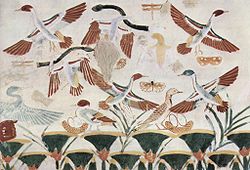HISTORIA9: HOISE HOINÚ O HONUT, ¿EL PRIMER MUNDO? AARÚ, ¿EL SEGUNDO MUNDO?
Aaru
Los campos de Aaru (Yaaru, Iaru, o Aalu), era el lugar paradisiaco donde reinaba Osiris, según la mitología egipcia.
El Aaru fue situado al Este, generalmente, por donde se eleva el Sol, y se describe como un campo eternamente fértil, o una serie de islas cubiertas de cañas (un campo de Juncos), similar al terrenal delta del Nilo: una zona de caza y pesca ideal. El lugar donde moraba Osiris también fue denominado, a veces, campo de ofrendas, Sejet Hetepet en egipcio antiguo.
Solamente a los espíritus cuyos actos pasados terrenales (conciencia y moralidad, representados por el corazón) pesaban igual que el Maat (la armonía cósmica, representada simbólicamente por una pluma) les era permitido comenzar un largo y peligroso viaje al Aaru, para disfrutar placenteramente por toda la eternidad.
Pero la vida nueva que comienza después de un juicio favorable no es, al principio, mejor o más espiritual que la vida en la tierra. El justo sigue siendo un caminante en un viaje largo y difícil para lograr alcanzar la dicha y seguridad en los fértiles campos de Aaru.
En este viaje estaba expuesto a múltiples peligros y, para evitarlos, el espíritu del difunto dependía de la energía y conocimientos que hubiera adquirido en la vida pasada, y de las palabras mágicas registradas en el libro de los muertos.
Además necesitaba la ayuda proporcionada por los parientes y amigos que aún vivían en la tierra, pues eran ellos los que aseguraban la conservación de su cadáver para que él pudiera volver y utilizarlo como tumba indestructible, hogar y abrigo de su Ka, necesitando alimento y bebida para su sustento, rezos y sacrificios para su salvación, y perseverar su recuerdo inscribiendo en los muros de la tumba, o escribiendo en rollos de papiro, capítulos del libro de los muertos, introducidos entre los vendajes de su cuerpo momificado.
[editar] Véase también
[editar] Bibliografía
- Budge, E. A. Wallis (2007). El libro egipcio de los muertos, Málaga: Editorial Sirio. ISBN 9788478085323.
- Lara Peinado, Federico (2009). Libro de los Muertos, Quinta edición. Madrid: Editorial Tecnos. ISBN 9788430948048.
Aaru
In ancient Egyptian mythology, the fields of Aaru (Egyptian:
iArw meaning "reeds") (alternatives: Yaaru, Iaru, Aalu) or the Egyptian reed fields, are the heavenly paradise, where Osiris ruled after he became part of the Egyptian pantheon and displaced Anubis in the Ogdoad tradition. It has been described as the ka (a part of the soul) of the Nile Delta.
Only souls who weighed exactly the same as the feather of the goddess Ma'at were allowed to start a long and perilous journey to Aaru, where they would exist in pleasure for all eternity. The ancient Egyptians believed that the soul resided in the heart. Those whose heart did not match the weight of the feather of Ma'at due to their sins were excluded. They were said to suffer a second death when devoured by another being, Ammit, while still in Duat for judgment.
The souls who did qualify had to undergo a long journey and face many perils before reaching Aaru. Once they arrived, they had to enter through a series of gates. The exact number of gates varies according to sources; some say 15, some 21. They are however uniformly described as being guarded by evil demons armed with knives.
Aaru usually was placed in the east, where the sun rises, and is described as eternal reed fields, very much like those of the earthly Nile delta: an ideal hunting and fishing ground, and hence, those deceased who, after judgment, were allowed to reside there, were often called the eternally living. More precisely, Aaru was envisaged as a series of islands, covered in "fields of rushes" (Sekhet Aaru), Aaru being the Egyptian word for rushes. The part where Osiris later dwelt was sometimes known as the "field of offerings", Sekhet Hetepet in Egyptian.
[edit] See also
[edit] Sources and references
| This article includes a list of references, related reading or external links, but its sources remain unclear because it lacks inline citations. Please improve this article by introducing more precise citations where appropriate. (September 2010) |
- Budge, Ernest Alfred Wallis (1906). The Egyptian Heaven and Hell. London: Kegan Paul, Trench, Trübner & Co., Ltd.. p. 37.
- Jobes, Gertrude. Dictionary of Mythology, Folklore, and Stymbols, Part 1. New York:The Scarecrow Press, 1962.
[edit] External links
| |||||||||||||||||||||||||||||||||||||||||||||||||||||
| This Ancient Egyptian religion article is a stub. You can help Wikipedia by expanding it. |

0 comentarios